Transforming Business—Successfully
July 08, 2015
"Enterprises everywhere are experiencing the 'business outcome gap.' The business outcome gap can be defined as the difference between desired business outcomes and realized business outcomes. Desired outcomes are changing in response to rapidly evolving stakeholder needs, whether the stakeholders are employees, customers, or shareholders. Globalization, disruptive technologies, smart devices, and social media have all had a profound effect on how we approach work and get important programs done. While realized outcomes may be improving, for most enterprises the increase in desired outcomes is far outstripping the realized. Not only do enterprises see a business outcome gap, but also the lack of innovation to stay relevant to the dynamic needs of the customer and market. In order to close the business outcome gap, constantly innovate, and get more customer centric, enterprises are increasingly embarking on business transformation programs or large-scale strategic projects. However, according to a recent study, organizations lose an average of a staggering $109 million for every $1 billion spent on projects."
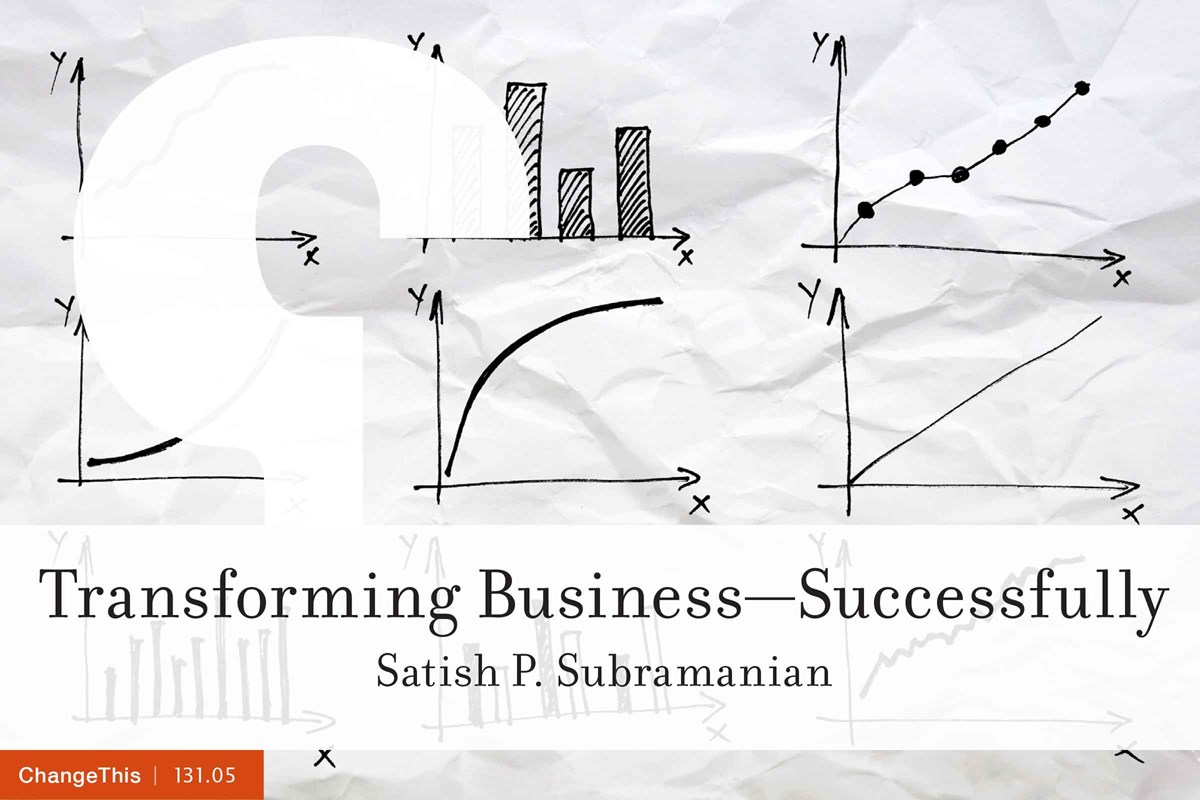 Enterprises need to constantly innovate business models, products, services, processes, and systems to maintain a strong competitive position in the market-place.
Enterprises need to constantly innovate business models, products, services, processes, and systems to maintain a strong competitive position in the market-place.
Enterprises architect and launch business transformation programs to drive such innovation. A business transformation program is a large-scale strategic initiative that drives substantial lasting change across functions. These transformation initiatives are launched by senior management within organizations to transform the business from the current to the future state. The typical financial outcomes expected in the future state attained by the transformation program are increasing revenues, improving earnings, and reducing costs. According to a recent survey of 1946 executives involved in business transformation initiatives, just 26% said their transformation was successful in improving performance and equipping the organization to sustain improvements over time (source: McKinsey Global Survey, November 2014).
Enterprises everywhere are experiencing the “business outcome gap.” The business outcome gap can be defined as the difference between desired business outcomes and realized business outcomes. Desired outcomes are changing in response to rapidly evolving stakeholder needs, whether the stakeholders are employees, customers, or shareholders. Globalization, disruptive technologies, smart devices, and social media have all had a profound effect on how we approachwork and get important programs done. While realized outcomes may be improving, for most enterprises the increase in desired outcomes is far outstripping the realized. Not only do enterprises see a business outcome gap, but also the lack of innovation to stay relevant to the dynamic needs of the customer and market. In order to close the business outcome gap, constantly innovate, and get more customer centric, enterprises are increasingly embarking on business transformation programs or large-scale strategic projects. However, according to a recent study, organizations lose an average of a staggering $109 million for every $1 billion spent on projects (source: Project Management Institute, “The High Cost of Low Performance,” February 2014).
Proven Framework for High Success Rate in Business Transformation
High performing enterprises, as well as those lagging the leaders, are always on the lookout for the levers that give them a business performance edge and always striving to maintain that edge. The business strategy discipline has numerous frameworks and tools that are used by enterprises to formulate their competitive strategies. Enterprises recognize the equal importance of possessing the strategic execution capability needed to effectively implement competitive strategy.
This “must have” strategic execution capability is also the capability of transformation program management. Enterprises typically launch a business transformation initiative to achieve strategic business objectives, realize desired business outcomes, and improve their competitive positioning. According to research conducted among 587 C-Suite and senior executives by the Economist Intelligence Unit, organizations can improve competitiveness by successfully executing initiatives in order to deliver strategic results. A transformation initiative could be structured either as a single large transformation program or multiple transformation programs with the program(s)
composed of numerous projects.
Enterprises need to understand and address the six dimensions (strategy, people, process, technology, structure, and measurement) in any transformation initiative they attempt. The transformation program management discipline can integrate and align these six dimensions during the business transformation journey. Business transformation programs can be executed from start (initiation) to finish (operational transition) through successful application of the end-to-end business transformation management life cycle. Transformation program management ensures the planned tangible and intangible benefits are realized in the designated time frame
and the realization of benefits results in a closure of the business outcome gap.
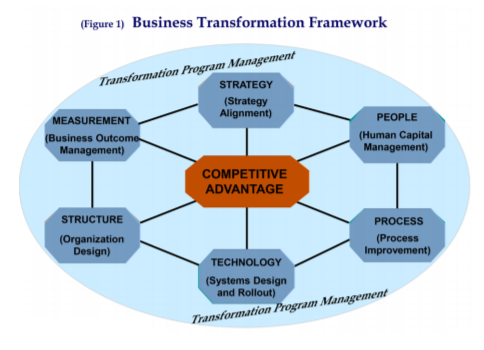
For business transformation projects to succeed in this shifting environment, organizations today must give renewed emphasis to the tenets of transformation program management, which provide the focus, structure, and discipline necessary to achieve desired business outcomes. A structured and rigorous transformation program management practice is critical to making a business transformation happen and sustain.
The multi-dimensional, integrative, and holistic framework of transformation program management enables enterprises to initiate, plan, execute, and monitor a transformation initiative. The business transformation framework integrates and aligns the six dimensions of strategy, people, process, technology, structure, and measurement in delivering the business outcomes, realizing the business benefits, producing the tangible and intangible business results, and sustaining the benefits. A high-level explanation of the six dimensions follows.
• Strategy | The transformation initiative undertaken by a program has to be aligned to the
organization strategy and the strategic objectives that need to be accomplished.
• People | Program management entails engaging with stakeholders, managing human capital,
and preparing the workforce to embrace the changes the business transformation is driving.
• Process | Typically, the business change architected by a complex transformation program,
requires the redesign of current business processes and implementation of the redesigned,
new processes.
• Technology | In light of the ever changing technologies and innovations they enable, most
transformation programs involve supporting the changes to the technology landscape.
• Structure | The current organizational model, role, and work location needs to be assessed
and restructured to attain and sustain the future state goal of a strategic initiative.
• Measurement | A measurement architecture has to be designed and implemented to monitor
and evaluate the delivery and sustainment of business value expected from a transformation.
Based on the context, situation, and nature of the transformation program, it is possible that
some of the above six dimensions may have to be worked less relative to the other dimensions
during certain phases of program execution. One additional lever of competitive advantage
for enterprises is building the transformation program management competency.
Business Transformation Architecture
The business transformation architecture provides the foundational platform for transformation by legitimizing the initiative and creating the burning platform to transform. All the six transformation program management dimensions of strategy, people, process, technology, structure, and measurement are taken into consideration in developing the business transformation architecture. The core foundation for a transformation program is its alignment to the strategic direction of the organization. The implementation of formulated business transformation strategy is facilitated by the business transformation architecture creation process. Business transformation architecture brings together the business and technical architectures and creates the overarching platform for implementing the strategy. Large enterprises typically frame up multiple strategic transformation initiatives to get from the current state to the transformed future state from an enterprise level perspective. The business objectives and business outcomes to be delivered in a certain time horizon are through multiple transformation initiatives. The business transformation architecture work also provides visibility into all the enterprise level transformation initiatives. In the context of a designated business transformation program that has been initiated, business transformation architecture analyzes the business problem thoroughly and architects the high-level approach to solve the problem.
After the program vision has been formulated, the business problem is analyzed as part of “current state” assessment, a blue print of the “future state” is next developed, and finally the transformation program is architected. This technique is utilized in the early stages of the business transformation journey to drive the “program discovery” stage whose output is instrumental in providing the launch platform for the transformation program.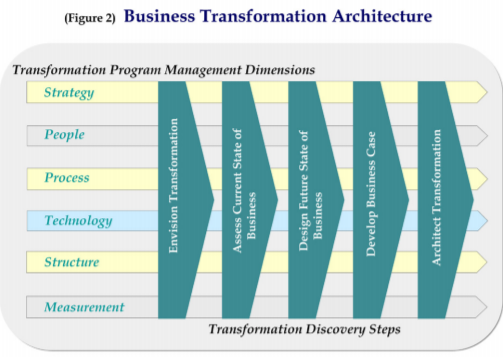 1. Envision transformation
1. Envision transformation
2. Assess current state of business
3. Design future state of business
4. Develop business case
5. Architect transformation
Roadmap for Higher Success in Business Transformation
The complexity of successfully delivering disruptive change that improves organization performance through a transformation journey is high. In addition, the risk of not realizing the expected business benefits from a business transformation program is high. Established transformation program managers with a highly successful track record, apply the “hard” program management skills (e.g., integration management, scope management, cost management, and time management) as well as the “soft” program management skills (e.g., consensus building, expectation management, decision framing, coaching, and motivating) to drive business transformation program
to success. Transformation program managers oversee the process of solving complex business challenges by driving end-to-end processes, managing project managers who oversee project work streams, and engaging with stakeholders to manage their expectations of program outcomes.
True transformation program management—and ultimately, program success—is best achieved
by flawless executing the below roadmap:
• Success Starts Upfront: Describe the Problem Accurately
• Articulate the Program Vision and Objectives
• Secure Cross-Functional Executive Sponsorship
• Develop and Implement a Governance Model
• Define Success, Outcomes, and Key Value Indicators
• Invest in Planning and Creating an Integrated Approach
• Drive Strong Partnership and Stakeholder Engagement
• Provide Leadership across all Levels
• Monitor aggressively and have Contingencies
• Create And Implement an Operations Transition Plan
Though the roadmap components are strategically sequenced, the planning and execution of the roadmap is an iterative exercise. The transformation program management team needs to have the capability (hard skills, soft skills, methods, processes, techniques, and tools) to execute against the roadmap.
Description of Business Transformation Roadmap
Each of the ten components of the transformation roadmap are equally important and needed to make a business transformation effort attain the future state objectives.
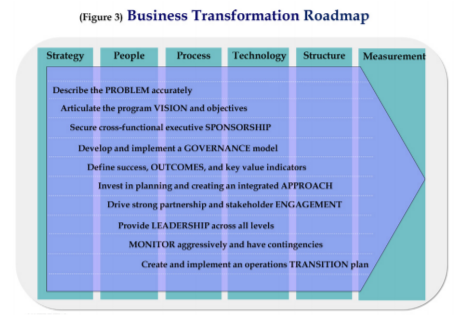
Success Starts Upfront | Describe the PROBLEM Accurately: The transformation program management team plays a critical role during the program frame up phase by ensuring there is due-diligence around business problem definition and alignment among the stakeholders on the problem the business transformation program will solve.
The common understanding and agreement of the problem statement among the stakeholders creates an invaluable platform the transformation program management team can further build upon as they drive the program forward.
Articulate the Program VISION and Objectives: As the transformation program management team drives forward the planning and execution of programs, all the stakeholders need to be cognizant of the program vision, program strategy, and program objectives. The periodic reinforcement of the transformation program vision and how the achievement of the program objectives will benefit everyone is one of the most important critical success factors for a transformation program.
Secure Cross-Functional Executive SPONSORSHIP: The sponsorship team needs to own the transformation program and be visibly involved. The sponsor alignment to the program strategy, vision, objectives, and outcomes needs to be evident to the transformation program stakeholders. A cross-functional and multi-level sponsorship model is needed to authorize and legitimize the transformation program. By addressing the program barriers, the sponsorship team positions the transformation program team to realize the desired business outcomes expected of the transformation program.
Develop and Implement a GOVERNANCE Model: For the transformation program to succeed, it is imperative to develop and implement the governance practices sooner rather than later. The key constituents of the transformation program governance model are — program organization structure, governing body definition, rollout of governance forums, program accountability, escalation paths, and decision-making processes.
Define Success, OUTCOMES, and Key Value Indicators: It’s critical to drive adequate clarity upfront on what constitutes transformation program success and how it is measured. Transformation program management has to constantly manage stakeholder expectations and validate there are no deviations from the original success definition and strategic criteria to judge success. The activities associated with business outcome life cycle management have to be planned in the integrated transformation program plan and those have to be executed
and monitored.
Invest in Planning and Creating an Integrated APPROACH: Transformation program planning assists in the development of a comprehensive program plan, which has numerous component plans including the business outcome realization plan. As the execution of the baselined integrated transformation program plan shifts the organization from the current to the desired future state, the program leadership team needs to proactively ensure organizational and individual readiness and acceptance to the strategic change.
Drive Strong Partnership and Stakeholder ENGAGEMENT: The lack of a comprehensive stakeholder engagement strategy and execution of that strategy along with the rest of the work driven by the business transformation management life cycle is a recipe for failure of the business transformation program. For transformation program to successfully deliver and sustain the strategic change, the core transformation program team has to proactively and effectively partner and engage with the identified stakeholders.
Provide LEADERSHIP Across all Levels: The complexity of business transformation programs requires cross-functional, cross-dimensional, and cross project leadership to realize the transformation program vision and sustain business outcomes. Displaying this leadership behavior and being a role model has to permeate through multiple levels of the transformation program organization and not just at the executive sponsor and steering committee levels. Leadership on the technical and human side is essential for the entire duration of the business transformation management life cycle.
MONITOR Aggressively and have Contingencies: Institutionalization of program controls is essential for efficient operational execution of the business transformation program and to position the program for success. Monitoring of transformation program milestones validates that the program timeline is in line with the integrated transformation program plan. Program monitoring process drives additional value into the business transformation program by creating opportunities for continuous improvements.
Create and Implement an Operations TRANSITION Plan: The organizational operational functions have to take ownership to move forward the charter of the business transformation program once it ceases to exist. The readiness of the organizational operations team is facilitated by the development and execution of the operational plan, training plan, and knowledge transfer plan. The embedment of continuous improvement practices and lessons learned exercises creates an operations environment that will sustain the delivery of expected business outcomes.
Business Transformation Management Life Cycle
The output of business transformation architecture exercise becomes the strategic input for the business transformation management life cycle - the four phase approach to drive a business transformation program from start-to-finish. This life cycle enables and sustains business transformation by articulating vision, developing an integrated transformation program plan, driving the plan, removing execution barriers, delivering planned business outcomes, and realizing business benefits.
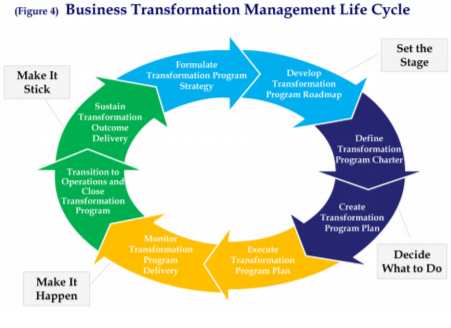
It also effectively transitions the future state attained by the transformation program to the operations function, which will own the ongoing execution and business outcome realization. The seamless integration of the business transformation architecture and the business transfor-mation management life cycle results in the end-to-end approach to implement the strategy to transform the business.
The business transformation management life cycle comprises four phases:
Phase One | Set the stage: The primary objective of this “set the stage” phase is to validate the transformation program mission, vision, and strategy and define the problem. Transformation program objectives, desired business outcomes, and high-level transformation program roadmap is developed. The “develop a program roadmap” process crafts the phased implementation plan after working through strategic implementation scenarios and analyzing their feasibility. The transformation program roadmap to get to the desired future transformed state typically encompasses sub-roadmaps e.g., people roadmap, process roadmap, and technology roadmap. The first phase of the business transformation management life cycle constitutes the following processes:
• Formulate transformation program strategy
• Develop transformation program roadmap
Phase Two | Decide what to do: In the “decide what to do” phase, the definition of success, problem validation, and program scope determination is completed. In addition, stakeholders are identified, an integrated detailed program plan is created, and transformation program plan is baselined. The “create the program plan” process builds out the comprehensive transformation program plan detailing the work to be performed under the program. This integrated transformation program plan enumerates the holistic approach to solve the defined business problem the business transformation program owns by accounting for all the six dimensions — strategy, people, process, technology, structure, measurement. The “decide what to do” phase entails the below two processes:
• Define transformation program charter
• Create transformation program plan
Phase Three | Make it happen: The work that needs to get done as part of the transformation program happens in this “make it happen” phase. As the transformation program plan is executed, the program monitoring function starts. This real time monitoring enables timely intervention, facilitates course correction, and validates program output is in line with the plan. The two high-level processes that accomplish the goals of “make it happen” phase:
• Execute transformation program
• Monitor transformation program delivery
Phase Four | Make it stick: The “make it stick” phase entails the various steps associated with the transition of transformation program to the operations function including transfer of knowledge. Realized program business outcomes are compared against expected program business outcomes and lessons learned analysis is accomplished. This last phase of the business transformation management life cycle comprise the following two processes:
• Transition to operations and close transformation program
• Sustain transformation outcome delivery
The eight processes comprising the business transformation management life cycle brings transformation to fruition by driving the steps needed to transition the business from the current state to the future state. Business transformation management recognizes that organizational change is required to realize and sustain the business outcomes targeted by the transformation program. The execution of the integrated transformation program plan drives and readies the organization to handle the business change. The business transformation management life
cycle is a key enabler for improving the success rate of business transformation programs. Enterprises that invest in bolstering their business transformation management capability and maturity levels are at a strategic advantage. Business transformation management improves organizational performance level and mitigates the enterprise risk of poor implementation of formulated business strategies. Competencies in business transformation management are a powerful competitive weapon as they enhance the strategic execution capabilities of enterprises.
Conclusion
Successful business transformation executes formulated strategies, delivers the intended future state, and sustains higher performance. Successful business transformation results in greater competitive advantage and improved financial outcomes of higher revenue, higher earnings, and reduced operational costs. In light of the disruptive change the business transformation initiatives are driving, the business complexity is high and business change is significant. Enterprises need a comprehensive framework for business transformation to deliver the desired business outcomes and realize the planned business benefits. The business transformation framework is the
glue that brings strategy, people, process, technology, structure, and measurement dimensions
together to enable the realization of benefits expected from a transformation initiative.
Enterprises need a methodical approach to successful execute transformation initiative and close the gap between the desired and realized business outcomes. The application of the methodical approaches of business transformation architecture coupled with the business transformation roadmap improves the success rate of business transformation. As organizations become more global and their business transformation initiatives get more complex, rigorous execution is critical to achieving the strategic objectives. The business transformation
management life cycle brings in the execution discipline and rigor. For organizations seeking a competitive edge, business transformation management is the “secret sauce” in achieving transformation program objectives, realizing program outcomes, delivering promised business results, and setting the stage for ongoing benefits realization.

